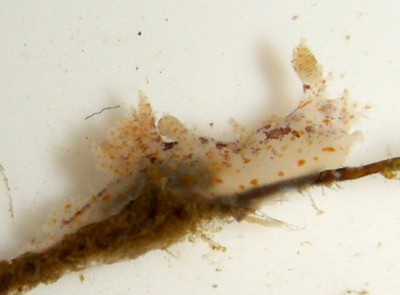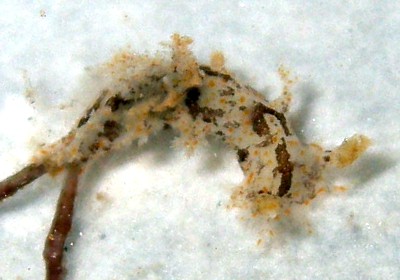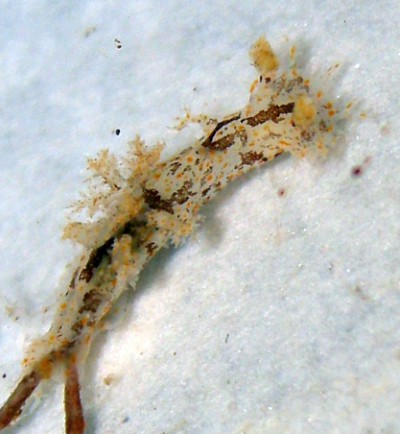Plocamopherus ceylonicus ? from Ratnagiri, India
June 1, 2009
From: Vishal Bhave


Concerning message #20584:
Found at low tide, Below rock in area of loose rocks. I have kept it alive to observe Luminescence, till today nothing was observed, maybe due to small size I can't observe that?
Locality: Rock patch, Mandavi, Ratnagiri , 0.5 feet, Maharashtra, India, Arabian sea , 27 May 2009, Intertidal, sandy with many small, loose rocks. Length: 8 mm. Photographer: Vishal Bhave.
Vishal Bhave
vishalbhave@gmail.com
Bhave, V.J., 2009 (Jun 1) Plocamopherus ceylonicus ? from Ratnagiri, India. [Message in] Sea Slug Forum. Australian Museum, Sydney. Available from http://www.seaslugforum.net/find/22507
Dear Vishal,
Thanks for these nice photos of an Indian Plocamopherus. I have always considered this species, with a dark brown symmetrical pattern and orange or yellow spots, to be Kelaart's Plocamopherus ceylonicus. As you can see on the Forum there is quite a colour variation but usually some sign of the spots and the dark brown pattern. When I saw your animal I thought I would compare it with the early paintings of Kelaart from Ceylon [message #2170] and Alder & Hancock from India [message #2171] that I have already posted on the Forum.
To my surprise these paintings have more in common to Valles & Gosliner's P. maculapodium which has been recently discussed on the Forum message #22501], than to the species I have identified as P. ceylonicus. In the paintings we can clearly see dark spots along the edge of the foot and a quick look at Kelaart's description showed he described his Polycera? zeylanica as: "Colour above bright orange-red, beneath whitish, with red specks seen through the transparent foot".
Unfortunately, Valles & Gosliner do not include P. ceylonicus in their review of the genus so I can't comment on their reasons for proposing the new species P. maculapodium. Two other new species in their paper, P. lemur and P. pecoso would also appear to be colour forms of this orange spotted 'species' and so is the animal they tentatively identify as P. imperialis, which looks rather different from the that species south eastern Australia.
It looks like we still have a bit of work to do on this genus.
Concerning the production of light by this species. I have only been able to make P. ceylonicus ( or at least what I call P. ceylonicus) and P. imperialis luminesce by 'unnatural' means - that is by a firm tap with a pair of forceps. I have never seen then doing it in the field or in an aquarium so I suspect it is a response to physical attack. Since their eyes aren't effective 'sight' organs, I can't see luminescence being of any use for signalling such as found in fireflies and glow worms. When I saw 'shedding light' in the title of Valles & Gosliner's paper I thought they might have some interesting new information on bioluminescence but sadly no.
-
Kelaart, E.F. (1858). Description of a new Ceylonese nudibranch. Annals and Magazine of Natural History, series 3, 1(4): 257-258
-
Valles, Y. & T.M. Gosliner. 2006. Shedding light onto the genera Kaloplocamus and Plocamopherus (Mollusca: Nudibranchia) with description of new species belonging to these unique bioluminescent dorids. The Veliger, 48: 178-205.
Best wishes,
Bill Rudman
Related messages
-
Re: Plocamopherus ceylonicus from Ratnagiri, India
From: Vishal Bhave, November 4, 2009 -
Plocamopherus ceylonicus from Ratnagiri, India
From: Vishal Bhave, October 26, 2009 -
Re: Cowry? from Townsville, Queensland
From: Melanie Wood, August 29, 2007 -
Plocamopherus ceylonicus from Western Australia
From: Bruce Potter, April 27, 2007 -
Plocamopherus ceylonicus from Western Australia
From: Brent Murdoch, February 27, 2007 -
Plocamopherus ceylonicus from Singapore
From: Toh Chay Hoon, February 27, 2007 -
Re: Plocamopherus tilesii from West Australia
From: Samantha Haebich, November 6, 2006 -
Re: Plocamopherus tilesii from Port Stephens, NSW
From: Samantha Haebich, October 31, 2006 -
Plocamopherus maculatus from Philippines
From: Jeff Rosenfeld, September 12, 2005 -
Plocamopherus ceylonicus from northern NSW
From: Denis Riek, July 23, 2004 -
Hong Kong Plocamopherus ceylonicus
From: W.B. Rudman & B.W. Darvell, March 11, 2002 -
Plocamopherus ceylonicus from the Marshalls
From: Scott Johnson, March 29, 2000 -
Plocamopherus ceylonicus - early paintings
From: Bill Rudman, March 29, 2000 -
Plocamopherus ceylonicus from Sulawesi
From: Lindsay Warren, March 28, 2000
